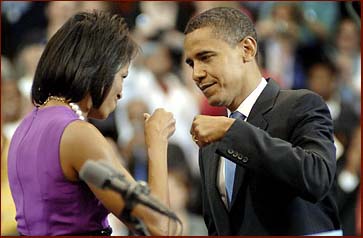
A Brief History of the Fist Bump!

JUNE 24, 2008
A Brief History of the Fist Bump
Barack and Michelle Obama bump fists before his victory appearance
AUTHOR: Craig Lassig

It's a hand gesture normally associated with sporting events and Bud Lite commercials. But on Tuesday night, millions of people witnessed Michelle Obama daintily knocking knuckles with her husband as the Illinois Senator took the stage to claim the 2008 Democratic presidential nomination. The Washington Post called it "the fist bump heard 'round the world."
The origins of the bump are murky, though most communication experts agree on a basic - if fuzzy - evolutionary timeline: the handshake (which itself dates back to ancient times) begat the "gimme-five" palm slap that later evolved into the now universal "high-five" and, finally, the fist bump.
Some claim the act of knuckle-bumping began in the 1970s with NBA players like Baltimore Bullets guard Fred Carter. Others claim the fist bump's national debut occurred off the court, citing the Wonder Twins, minor characters in the 1970s Hanna-Barbera superhero cartoon The Superfriends, who famously touched knuckles and cried "Wonder Twin powers, activate!' before morphing into animals or ice sculptures. One might also credit germaphobics for the fist bump's popularity. Deal or No Deal host Howie Mandel reportedly adopted the gesture as a friendly way to avoid his contestants' germs.
Even the terminology used to describe the manual move is under dispute. On reporting Obama's speech, The New York Times described it stuffily as a "closed-fisted high-five" while Human Events racily suggested it was closer to "Hezbollah-style fist-jabbing," (the phrase was later removed from the article). One Internet poster even referred to it as "the fist bump of hope." Other terms for the move include "power five," "fist pound," "knuckle bump," "Quarter Pounder" and "dap."
The fist bump's precursor, the low- and high-fives, originated in the 1950s, again mostly among athletes, who deemed handshakes too muted and formal for celebrating teamwork and triumph.
The 1980s are generally regarded as the heyday of the high-five, though the gesture has enjoyed a revival of sorts in recent years - especially among Gen-X parents and their offspring. Modern-day high-five enthusiasts have even created a cellphone version: Callers high-five their phones (slap the speakers) or simultaneously type "5."
The problem with the high-five is that it can occasionally be hard to pull off. Just ask Tiger Woods and his caddie, who botched a high-five on national TV during the 2005 U.S. Masters Golf Tournament. Perhaps this is what makes the fist bump so unique. Though simple in motion, its meaning is far more complicated. In any other context, a clenched fist would be perceived as hostile.
Ambiguities aside, most pundits and observers alike had complimentary words for the Obama family's fist bump, seeing it as a rare moment of spontaneity and playfulness that a race already in its 17th month sorely needed.
"Gestures, particularly ones that are recent, haven't been studied that much," says David Givens, director of the Center for Nonverbal Studies in Spokane, Wash. "For me, it's ironic because we all noticed that fist bump. I thought it was very touching. It was an elegant little non-verbal moment and it gave us a view into their relationship."
For his part, Obama, who once likened himself to NBA star LeBron James, said the fist bump reflects a marriage that keeps him grounded. "It captures what I love about my wife," he later explained to NBC's Brian Williams. "That for all the hoopla I'm her husband and sometimes we'll do silly things."
Though National High-Five Day already exists - the third Thursday in April every year - the fist bump has yet to claim its own day on the calendar. June 3rd might be a good candidate.
Source: Time.com
Related sources:
The hand of Barack Obama: a tribute to his hands!
History of the fist bump
Shake it up: the fist bump
Hand Gestures dramatically improve learning!
Hand Gestures help solve math problems
Language might have evolved from Hand Gestures
Hand Gestures control your TV
Talk to the Hand